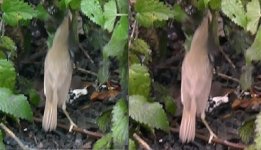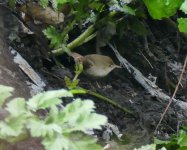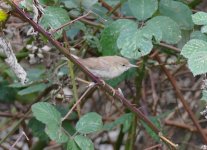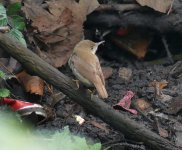KenM
Well-known member
Putative fuscus re-visited.
Charles Hi,
Having put a lot of time into this exercise, I'm now of the opinion that a change of tack (re-assessment) might be more prudent.
This bird has certainly become a ''real'' learning curve for me, principally because of the pallor, and the seemingly long pp which in no small way had a major influence, in sending me down the fuscus road.
Also not helping in this instance, was sustained exposure to a contender ''classic'' BRW during Oct.2001, which couldn't have looked more different, ie. olive grey uppers, grey tarsi and a c50% pp to tertial ratio. Comparing ratios it would appear (depending on what you read) that e.g. BRW's pp ratio can be between one and two thirds of overlying tertials, compared to Marsh/Reed which are between 65-100%. If images are anything to measure against, then this two thirds maximum might have even greater flexibility if the ''variable'' cosmetics are anything to go by?
Having taken many shots over the period, and subsequently found a number of features that perhaps at best, might be considered questionable regarding Caspian Reed Warbler as a putative candidate.
Firstly, the Iris colour appears to be contrastingly grey in most images, this would seem to be at odds with all Reed Warbler images that I have trawled on the web (mid-dark brown, being the principal colour throughout), although a couple of BRW's looked to have a paler Iris.
Secondly, the general concolourousness of the upper-parts might also, not be helpful for A.scirpaceous, perhaps more akin to BRW?
The bare-parts colouring ie. lower mandible, legs, toes and claws!, appear to exhibit a strong yellow wash in most lights, again perhaps not really compatible with Reed, A.scirp., although contrary to most text, certainly appears to be seen occasionally on BRW?
The bird also appears to show better in some images than others, a smaller emargination on p4 (further down the wing) as well as p3, this as I understand it, can be compatible with Casp.RW/BRW...whilst excluding RW.
Charles as you have suggested that a Marsh/BRW hybrid might be a candidate? possibly explaining it's apparent wing length and current Wintering site, at a ''lost'' point between Africa and India...far fetched and unlikely perhaps?
Further on, the moulting period for RW generally runs between early Oct-early Nov. and later for BRW and Caspian (leading up to, and just before Spring departure), perhaps time might tell?
Cheers
Charles Hi,
Having put a lot of time into this exercise, I'm now of the opinion that a change of tack (re-assessment) might be more prudent.
This bird has certainly become a ''real'' learning curve for me, principally because of the pallor, and the seemingly long pp which in no small way had a major influence, in sending me down the fuscus road.
Also not helping in this instance, was sustained exposure to a contender ''classic'' BRW during Oct.2001, which couldn't have looked more different, ie. olive grey uppers, grey tarsi and a c50% pp to tertial ratio. Comparing ratios it would appear (depending on what you read) that e.g. BRW's pp ratio can be between one and two thirds of overlying tertials, compared to Marsh/Reed which are between 65-100%. If images are anything to measure against, then this two thirds maximum might have even greater flexibility if the ''variable'' cosmetics are anything to go by?
Having taken many shots over the period, and subsequently found a number of features that perhaps at best, might be considered questionable regarding Caspian Reed Warbler as a putative candidate.
Firstly, the Iris colour appears to be contrastingly grey in most images, this would seem to be at odds with all Reed Warbler images that I have trawled on the web (mid-dark brown, being the principal colour throughout), although a couple of BRW's looked to have a paler Iris.
Secondly, the general concolourousness of the upper-parts might also, not be helpful for A.scirpaceous, perhaps more akin to BRW?
The bare-parts colouring ie. lower mandible, legs, toes and claws!, appear to exhibit a strong yellow wash in most lights, again perhaps not really compatible with Reed, A.scirp., although contrary to most text, certainly appears to be seen occasionally on BRW?
The bird also appears to show better in some images than others, a smaller emargination on p4 (further down the wing) as well as p3, this as I understand it, can be compatible with Casp.RW/BRW...whilst excluding RW.
Charles as you have suggested that a Marsh/BRW hybrid might be a candidate? possibly explaining it's apparent wing length and current Wintering site, at a ''lost'' point between Africa and India...far fetched and unlikely perhaps?
Further on, the moulting period for RW generally runs between early Oct-early Nov. and later for BRW and Caspian (leading up to, and just before Spring departure), perhaps time might tell?
Cheers







